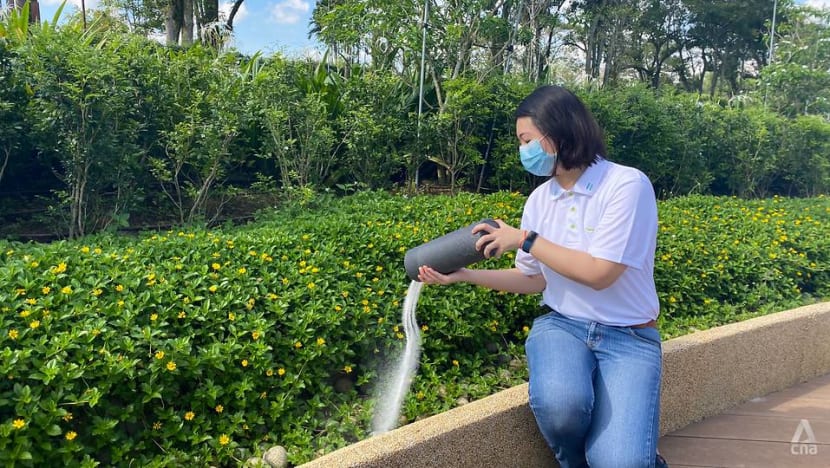Increasing demand for scattering of ashes in garden at Choa Chu Kang Cemetery
With Singapore's rapidly ageing population, annual deaths are expected to increase from around 25,000 currently to about 60,000 by the 2060s, Senior Parliamentary Secretary for Sustainability and the Environment Baey Yam Keng said.

A demonstration of ash scattering at the Garden of Peace at Choa Chu Kang Cemetery Complex. (Photo: Ang Hwee Min)

This audio is generated by an AI tool.
SINGAPORE: Demand for inland ash scattering has steadily increased since the first such facility was opened in 2021, Senior Parliamentary Secretary for Sustainability and the Environment Baey Yam Keng said on Tuesday (Feb 6).
Mr Baey was responding in parliament to questions from MP Carrie Tan (PAP-Nee Soon), who asked if Singapore has considered innovative ways to process remains of the deceased and whether the Ministry of Sustainability and the Environment (MSE) would channel resources towards efforts to change the mindsets of Singaporeans towards after-death facilities.
The first inland ash scattering facility, the Garden of Peace in Choa Chu Kang Cemetery, was opened in May 2021 to provide more options for the public to manage cremated ashes.
The public can scatter the ashes of their loved ones into four ash scattering lanes at the garden. Families can then use watering cans provided to water the area where the ash was scattered, to ensure the ashes sink into the soil. Sprinklers will also wash the ashes into the soil at the end of the day.
"Since its introduction, there has been increasing demand for (inland ash scattering), with the number of applications increasing steadily from about 900 in 2021 to about 2,000 in 2023," said Mr Baey in his reply.
The numbers represent an increase from what the National Environment Agency (NEA) gave last year.
The agency told the Straits Times in the middle of last year that the garden saw a 40 per cent increase - about 150 applications a month - from the time it opened.
A second inland ash scattering facility, the Garden of Serenity, is being constructed with the new Mandai Crematorium Complex and is expected to open next year.
With Singapore's rapidly ageing population, annual deaths are expected to increase from about 25,000 currently to about 60,000 by the 2060s, Mr Baey noted.
"The National Environment Agency (NEA) therefore, works closely with land use planning agencies such as the Urban Redevelopment Authority to plan ahead for more after-death facilities such as funeral parlours, wake halls and columbaria to ensure adequate capacity," he said.
He noted that such facilities will inevitably be a more prevalent feature of Singapore's urban landscape.
Singaporeans "by and large" accept the need for such facilities, which are developed in a way that takes into consideration and integrates with the surrounding community, said Mr Baey.
Currently, most bereaved facilities will opt to cremate their loved ones' bodies if their religion does not require burial, he said. Cremated ashes will typically be placed in niches.
Inland ash scattering was introduced in 2021 to provide more options to handle cremated ashes. It requires less land compared to traditional niches and is cheaper when compared to niche fees.
"Besides (inland ash scattering) and niches, families can also place ashes of departed loved ones at home or scatter them at sea. NEA will continue to study methods of intensifying land use and design at future facilities to minimise the land required and optimise land usage," Mr Baey said.
But more can be done to improve the public's acceptance of after-death facilities, starting with raising awareness of end-of-life planning and post-death matters, he added.
In the same vein, My Legacy@LifeSG was launched in 2020 as a one-stop portal on end-of-life planning and post-death matters. Through the portal, Singaporeans can download death certificates, arrange a funeral, or manage the deceased's assets, among other services.
Mr Baey also cited ongoing efforts to work with different stakeholders, such as Singapore Hospice Council, to engage the public on normalising conversations on death and dying.
SPREAD OUT
Ms Tan asked if the ministry should look at more innovative and sustainable ways of treating loved ones' remains rather than "fall back on the conventional and convenient solution of concentrating the niches and columbaria in one area".
She pointed out that the construction of Mandai Columbarium Complex meant that about half of Singapore's niches are going to be located in the north.
"I think residents are expecting that the ministry can do more to accelerate the conversations on this and to accelerate different solutions to see how we can decentralise niches," she added.
"So that this amenity does not need to be unfairly concentrated in one area, but can be seen as an amenity that's accessible to all Singaporeans."
In response, Mr Baey said there were around 70 private and government columbaria across Singapore, not just in the north.
He said that MSE and NEA work closely with other ministries and agencies to seek sites for the development of after-death facilities in the medium and long term across Singapore.
Ms Tan also sought commitment from the ministry to accelerate efforts into looking into other innovative ways of treating after-death remains. These could include scattering ashes around trees and cremation diamonds, where the ashes of loved ones are processed into a diamond as a keepsake. Such services are offered by certain funeral parlours or jewellers here.
These solutions require very little space, and are more viable and tenable in the long term, said Ms Tan.
Mr Baey replied that the ministry was aware of these options.
"But as I said, when the government looks at providing such services or facilities, we have to make it affordable for most - if not all - Singaporeans," he said.
"Of course, if there are private operators who are offering such different types of services, you know, we can work with them and they can offer these more interesting options for Singaporeans."
















